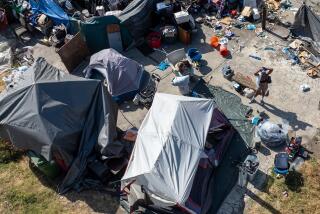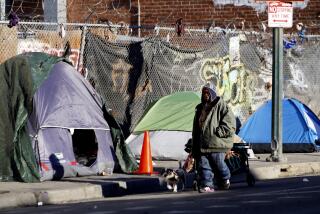Gaps Reported in Aid to Mentally Ill Homeless
A statewide program that gives counties more than $20 million annually to help homeless people who are mentally ill has enjoyed some success but still leaves “significant gaps” in addressing their mental health needs, according to a Rand Corp. study released Wednesday.
The report, prepared for the state Department of Mental Health, said counties participating in the 3-year-old program have assisted thousands of homeless people with food, clothing, shelter and other services under the 1985 state Mental Health Services Act.
That legislation, more commonly known as the Bronzan-Monjonnier Act, had marked the first statewide effort to specifically target funds for the homeless who are mentally ill. About $60 million has been parceled out for that purpose over the last three years with more than a third of that amount going to Los Angeles County.
In the first comprehensive look at how that money has been spent, the Rand study said the program has met the legislative goal.
“We found that most of the programs funded under the state are operating at capacity and are effectively targeting the (homeless) population that the Legislature intended,” said Georges Vernez, research team leader for the Rand study.
But, while lauding some county efforts, the researchers warned that “significant gaps remain in the amount and types of services available to the (homeless mentally disabled).” In particular, the study said more efforts are needed to find the severely mentally ill among the homeless and then arrange treatment and other services.
Among those still greatly under-served, according to the Rand study, are the severely mentally ill, as well as the mentally disabled who are not only homeless but also abuse alcohol or drugs. The study noted that a high percentage of homeless women have severe mental disorders and are not receiving adequate attention.
Severe Mental Disorders
The Rand report estimated that about 30% of the homeless suffer from severe mental disorders such as schizophrenia or major depression, basing the finding on a survey of the homeless in three counties--Alameda, Orange and Yo-lo--coupled with additional data from a prior study of the homeless in the Los Angeles downtown Skid Row area.
The study also pointed out that more than two out of three homeless people who have severe mental disorders also have a history of drug or alcohol abuse, and more than one in three usually do not get enough to eat on a daily basis.
In tracking individuals for the homeless survey, researchers frequented alleys, all-night coffee shops, riverbeds and other areas in Alameda, Orange and Yolo counties. They also conducted telephone interviews with officials in 17 other counties to review homeless programs before concluding that many service providers are already overburdened and that many homeless mentally ill “are not being served because needs exceed capacity.”
The Rand assessment of the homeless mentally ill programs as well as the descriptions of the homeless population had been eagerly anticipated by legislators and mental health officials as the most comprehensive review yet of the state’s mentally ill homeless.
“I am very satisfied with the overall results of the study because it speaks highly of what local mental health departments are doing with the money they have,” said Walter Watson, coordinator for homeless mentally disabled programs for the state Department of Mental Health.
‘Serving the Target Population’
“The basic conclusion is that our program is serving the target population and living up to the spirit and intent of the legislation,” Watson said. Only Alpine and Siskiyou counties declined to participate in the program, he said.
Assemblyman Bruce Bronzan (D-Fresno), who co-authored the mental health bill, said the Rand study, which cost $250,000, underscored the need for the state to do even more to help the homeless mentally disabled.
“This is just a small beginning,” he said. “There are far more people who are out there who are homeless and mentally disabled who are not getting help. That’s the message. This was only a modest beginning.”
WHO ARE THE HOMELESS MENTALLY ILL? The RAND Corp. studied the link between mental illness and homelessness in three California counties, as well as in Los Angeles’ Skid Row area. The table below gives a demographic breakdown, in weighted percentages, of homeless people with severe mental disorders, which include schizophrenia and major depression. The results were drawn from interviews with 315 homeless adults in the three counties and from a Los Angeles County study of the homeless mentally ill on Los Angeles’ Skid Row.
THREE-COUNTY L.A’s AVERAGE ALAMEDA ORANGE YOLO SKID ROW SEX Female 38 21 62 12 5 Male 62 79 38 88 95 AGE 18-24 22 19 26 15 11 25-34 37 40 38 4 39 35-44 28 31 25 25 27 45-54 9 7 7 37 14 55+ 4 3 5 9 9 ETHNICITY Latino 7 5 10 9 12 Anglo 47 36 56 79 36 Black 34 49 21 0 48 Other 12 10 13 12 4 MARITAL STATUS Married 13 8 19 9 2 Widowed 3 0 5 9 6 Separated 14 17 12 3 17 Divorced 25 22 23 49 19 Never married 46 52 41 30 57 MILITARY Vietnam 10 13 4 25 20 And/or other 11 14 5 31 19 No service 79 75 92 45 61
More to Read
Sign up for Essential California
The most important California stories and recommendations in your inbox every morning.
You may occasionally receive promotional content from the Los Angeles Times.









